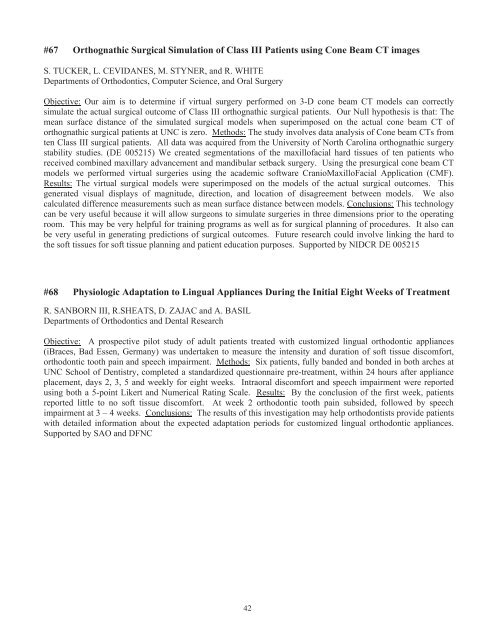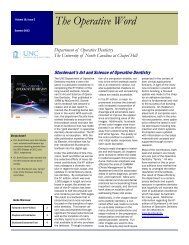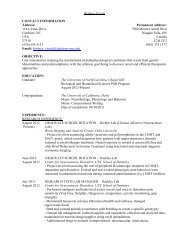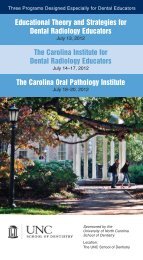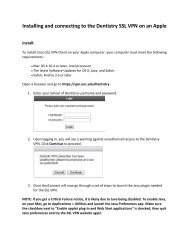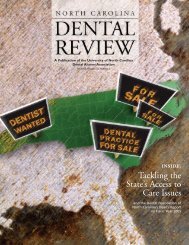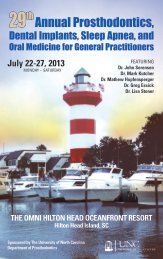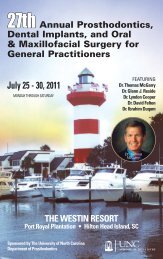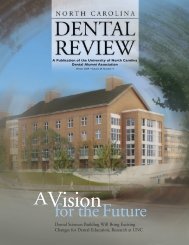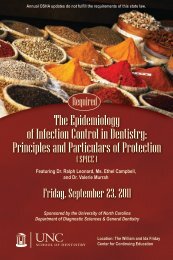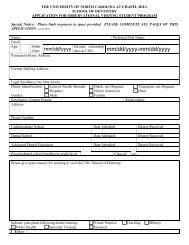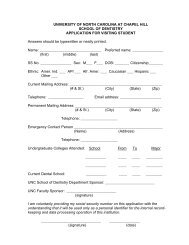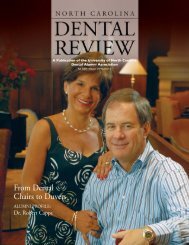#67 Orthogn<strong>at</strong>hic Surgical Simul<strong>at</strong>ion <strong>of</strong> Class III P<strong>at</strong>ients using Cone Beam CT imagesS. TUCKER, L. CEVIDANES, M. STYNER, and R. WHITEDepartments <strong>of</strong> Orthodontics, Computer Science, and Oral SurgeryObjective: Our aim is to determine if virtual surgery performed on 3-D cone beam CT models can correctlysimul<strong>at</strong>e the actual surgical outcome <strong>of</strong> Class III orthogn<strong>at</strong>hic surgical p<strong>at</strong>ients. Our Null hypothesis is th<strong>at</strong>: <strong>The</strong>mean surface distance <strong>of</strong> the simul<strong>at</strong>ed surgical models when superimposed on the actual cone beam CT <strong>of</strong>orthogn<strong>at</strong>hic surgical p<strong>at</strong>ients <strong>at</strong> <strong>UNC</strong> is zero. Methods: <strong>The</strong> study involves d<strong>at</strong>a analysis <strong>of</strong> Cone beam CTs fromten Class III surgical p<strong>at</strong>ients. All d<strong>at</strong>a was acquired from the <strong>University</strong> <strong>of</strong> <strong>North</strong> <strong>Carolina</strong> orthogn<strong>at</strong>hic surgerystability studies. (DE 005215) We cre<strong>at</strong>ed segment<strong>at</strong>ions <strong>of</strong> the maxill<strong>of</strong>acial hard tissues <strong>of</strong> ten p<strong>at</strong>ients whoreceived combined maxillary advancement and mandibular setback surgery. Using the presurgical cone beam CTmodels we performed virtual surgeries using the academic s<strong>of</strong>tware CranioMaxilloFacial Applic<strong>at</strong>ion (CMF).Results: <strong>The</strong> virtual surgical models were superimposed on the models <strong>of</strong> the actual surgical outcomes. Thisgener<strong>at</strong>ed visual displays <strong>of</strong> magnitude, direction, and loc<strong>at</strong>ion <strong>of</strong> disagreement between models. We alsocalcul<strong>at</strong>ed difference measurements such as mean surface distance between models. Conclusions: This technologycan be very useful because it will allow surgeons to simul<strong>at</strong>e surgeries in three dimensions prior to the oper<strong>at</strong>ingroom. This may be very helpful for training programs as well as for surgical planning <strong>of</strong> procedures. It also canbe very useful in gener<strong>at</strong>ing predictions <strong>of</strong> surgical outcomes. Future research could involve linking the hard tothe s<strong>of</strong>t tissues for s<strong>of</strong>t tissue planning and p<strong>at</strong>ient educ<strong>at</strong>ion purposes. Supported by NIDCR DE 005215#68 Physiologic Adapt<strong>at</strong>ion to Lingual Appliances During the Initial Eight Weeks <strong>of</strong> Tre<strong>at</strong>mentR. SANBORN III, R.SHEATS, D. ZAJAC and A. BASILDepartments <strong>of</strong> Orthodontics and Dental ResearchObjective: A prospective pilot study <strong>of</strong> adult p<strong>at</strong>ients tre<strong>at</strong>ed with customized lingual orthodontic appliances(iBraces, Bad Essen, Germany) was undertaken to measure the intensity and dur<strong>at</strong>ion <strong>of</strong> s<strong>of</strong>t tissue discomfort,orthodontic tooth pain and speech impairment. Methods: Six p<strong>at</strong>ients, fully banded and bonded in both arches <strong>at</strong><strong>UNC</strong> <strong>School</strong> <strong>of</strong> <strong>Dentistry</strong>, completed a standardized questionnaire pre-tre<strong>at</strong>ment, within 24 hours after applianceplacement, days 2, 3, 5 and weekly for eight weeks. Intraoral discomfort and speech impairment were reportedusing both a 5-point Likert and Numerical R<strong>at</strong>ing Scale. Results: By the conclusion <strong>of</strong> the first week, p<strong>at</strong>ientsreported little to no s<strong>of</strong>t tissue discomfort. At week 2 orthodontic tooth pain subsided, followed by speechimpairment <strong>at</strong> 3 – 4 weeks. Conclusions: <strong>The</strong> results <strong>of</strong> this investig<strong>at</strong>ion may help orthodontists provide p<strong>at</strong>ientswith detailed inform<strong>at</strong>ion about the expected adapt<strong>at</strong>ion periods for customized lingual orthodontic appliances.Supported by SAO and DFNC42
#69 Evalu<strong>at</strong>ion <strong>of</strong> Stress Gener<strong>at</strong>ion in Alveolar Bone During Orthodontic Miniscrew UseUnder Varied Conditions: A Finite Element AnalysisJ.K. POLLEI, C-C. KO, and J.F.C. TULLOCHDepartment <strong>of</strong> OrthodonticsObjective: Stress may be associ<strong>at</strong>ed with loosening and instability <strong>of</strong> orthodontic miniscrews, thereby contributing tominiscrew failure. This study used finite element analysis (FEA) to evalu<strong>at</strong>e stress in alveolar bone when loads areapplied to miniscrews <strong>of</strong> varying angul<strong>at</strong>ions, designs and m<strong>at</strong>erial types. Methods: Models <strong>of</strong> the maxillary leftposterior dentoalveolar complex were constructed from μCT d<strong>at</strong>a with Solidworks®. Computer aided design models <strong>of</strong>TOMAS® and IMTEC® orthodontic miniscrews were inserted buccally between the second premolar and first molar <strong>at</strong>angul<strong>at</strong>ions <strong>of</strong> 45°, 60°, and 90° to the cortical bone surface. A 150g retraction load was placed. Miniscrew compositionwas varied from titanium (Ti) to stainless steel (SS) to composite (Comp) m<strong>at</strong>erials. Cortical bone modulus was variedfrom low to high (5-20GPa). Models were solved with ANSYS 10.0 and stress components were compared betweenangul<strong>at</strong>ions. Results: In all models stress p<strong>at</strong>terns were similar in loc<strong>at</strong>ion and magnitude. Maximum principle stresses(MPS) were loc<strong>at</strong>ed distal to the miniscrews. Gre<strong>at</strong>est von Mises stresses were diffused around the miniscrew/boneinterface. Tensile stress was gre<strong>at</strong>est <strong>at</strong> 45° and least <strong>at</strong> 90°, and did not exceed ultim<strong>at</strong>e tensile strength values <strong>of</strong>cortical bone <strong>at</strong> any angul<strong>at</strong>ion. Von Mises stress was lowest in TI, and slightly higher in Comp and SS. At low corticalbone modulus, MPS was gre<strong>at</strong>er for TOMAS than IMTEC models while Von Mises stress was similar for both. Athigher cortical bone modulus both MPS and von Mises stress decreased in the TOMAS model and increased in theIMTEC model. Conclusions: Miniscrew angul<strong>at</strong>ion, when using clinically accepted loads, does not appear to be a factorth<strong>at</strong> contributes to tensile failure in bone. Maximum stress in every model was far below the ultim<strong>at</strong>e tensile strength <strong>of</strong>cortical bone or any m<strong>at</strong>erial tested. <strong>The</strong> stress properties <strong>of</strong> SS and Comp miniscrews compare favorably to Ti,indic<strong>at</strong>ing these m<strong>at</strong>erials may be feasible altern<strong>at</strong>ives in clinical use. Differing miniscrew designs may account fordifferences in alveolar bone stress p<strong>at</strong>terns, but no clinically appreciable difference exists between miniscrewsevalu<strong>at</strong>ed. Supported by: SAO, NIDCR, NC Biotech Center, AAOF#70 Rel<strong>at</strong>ionship <strong>of</strong> Mandibular Canal and Fix<strong>at</strong>ion Placement to Sensory Alter<strong>at</strong>ion FollowingOrthogn<strong>at</strong>hic SurgeryG. TUCKER, C. PHILLIPS, L. CEVIDANES, and G. BLAKEYDepartments <strong>of</strong> Orthodontics and Oral & Maxill<strong>of</strong>acial SurgeryObjectives: Altered sens<strong>at</strong>ion is a common sequelae <strong>of</strong> orthogn<strong>at</strong>hic surgery involving the mandible. <strong>The</strong> etiology <strong>of</strong>altered sens<strong>at</strong>ion following this surgery has been <strong>at</strong>tributed to injury during tissue dissection, direct trauma from the split,stretching or compression <strong>of</strong> the nerve during and following surgical manipul<strong>at</strong>ion as well as compression <strong>of</strong> the nervefollowing fix<strong>at</strong>ion. <strong>The</strong> objective <strong>of</strong> this pilot study was to assess the associ<strong>at</strong>ion <strong>of</strong> morphological and surgical factorsrel<strong>at</strong>ed to mandibular canal loc<strong>at</strong>ion and post-surgical neurosensory alter<strong>at</strong>ion over 2 years as quantified by contactdetection in p<strong>at</strong>ients having a BSSO. Methods: 3D side-specific measurements were obtained from cone Beam CT(CBCT) scans taken before and after orthogn<strong>at</strong>hic surgery: pre-surgery, distance from the buccal and lingual corticalpl<strong>at</strong>es to the mandibular nerve canal; post-surgery, distance from the nerve canal to the nearest fix<strong>at</strong>ion screw, thedistance the osteotomy and nerve canal were coincident, and the amount <strong>of</strong> mandibular advancement. Contact detectionwas performed with nylon mon<strong>of</strong>ilaments representing multiple force levels before and 1,3,6,12, and 24 months aftersurgery. Results: <strong>The</strong> mean age <strong>at</strong> the time <strong>of</strong> surgery was 31.14 years old. Eighty three percent <strong>of</strong> the subjects werefemale. On both the right and left sides the average minimum distance from the lingual cortical pl<strong>at</strong>e to the inferioralveolar canal (IAC) was less than the distance from the IAC to the buccal cortical pl<strong>at</strong>e. <strong>The</strong> average distance from thesurgical fix<strong>at</strong>ion screws to the IAC was approxim<strong>at</strong>ely 1mm less on the left side. <strong>The</strong>re were no consistent st<strong>at</strong>isticallysignificant correl<strong>at</strong>ions between the an<strong>at</strong>omical or surgical measured distances and the impairment in contact detectionfollowing orthogn<strong>at</strong>hic surgery. Conclusions: Our preliminary study indic<strong>at</strong>es th<strong>at</strong> quantit<strong>at</strong>ive 3D assessment <strong>of</strong> theIAC trajectory and position in rel<strong>at</strong>ion to pre-surgical an<strong>at</strong>omical factors and post-surgical fix<strong>at</strong>ion position is plausibleusing CBCT. This methodology will allow for future in depth analysis <strong>of</strong> an<strong>at</strong>omical rel<strong>at</strong>ionships and surgery rel<strong>at</strong>edfactors and their effects on sensory alter<strong>at</strong>ions following orthogn<strong>at</strong>hic surgery. Supported by NIH Grants DE005215 andDE01367 and the SAO43


